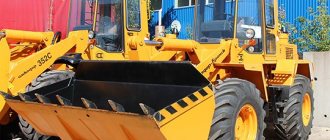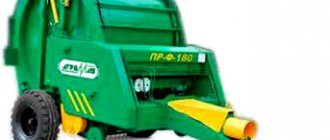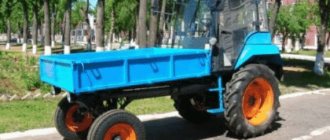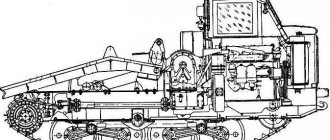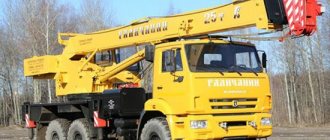The T-25 tractor is a small-sized representative of wheeled universal row-crop equipment. Belongs to the class of agricultural vehicles with a low traction class; the T-25 engine does not differ in power.
At the same time, the T-25 has increased maneuverability, versatility and an affordable price. The tractor is popular among farmers; modern modifications of the vehicle are purchased by farmers and individual agricultural producers.
Equipped with a trailer, the vehicle is in demand in the service sector and housing and communal services.
The T-25 is readily used by economic entities of the national economy. Since 1972, the tractor has been produced at one enterprise, the Vladimir Motor and Tractor Plant (VMTZ).
Based on the name of the tractor-building city, the agricultural machine was commonly called “Vladimirets”, and became the calling card of the plant.
Weighing 1,780 kg, the “long-lived domestic tractor manufacturer” moves at a speed of 21.6 km/h.
Depending on the modification, the model is equipped with rear-wheel drive or all-wheel drive; if necessary, the design can be adjusted for long-term operation in reverse.
The T-25 is equipped with a 540 rpm power take-off shaft and a drive pulley for connecting external devices and agricultural machines.
A semi-trailer, hydraulic attachments and attachments operate from a hydraulic cylinder.
Reliable operation of power systems with a traction force of 0.6 t is ensured by the T-25 diesel engine. It used the D-21, D21A and D-120 models at different times.
The history of modifications is more than half a century long
Initially, the engine power was 14.6 hp.
Given that at that time the weight of the special transport itself was 1780 kg, this was not enough to complete the assigned tasks. Starting with T - 25A, diesel power increased to 26.6 hp. It spun the flywheel up to 1800 rpm, which ensured movement and work with hydraulic attachments or trailed equipment.
New technical characteristics for the T-25 were provided by the D-21A model. Unlike the D-21, it was equipped with a distribution fuel pump of the ND-21/2 type.
The plunger made 2 times more strokes per revolution of the drive shaft. This made it possible to increase the power of the vehicle.
Today the D-21 is produced under the updated D-120 brand. As a result of modernization, the operating power of the engine increased to 30 hp.
But the main achievement of the new VMTZ model was not the improvement in power characteristics. This diesel engine uses a balancing mechanism of the original design for the first time.
It eliminated the long-standing “trouble” of two-cylinder engines – vibration of the engine and, as a consequence, of the tractor itself.
Tuning
Tractor engines are not subject to tuning for the simple reason that tractors are initially designed to perform specific tasks. The design of their power units is carried out comprehensively. At the same time, the combination of basic technical parameters of both power units and the vehicles themselves is optimized. Of course, you can, for example, increase the engine power by boring its cylinders, but this will lead to malfunction:
- transmissions;
- auxiliary systems (lubrication, cooling, etc.);
- changes in the coefficients of adhesion of tires to the ground, etc.
In addition, such work is highly complex, time consuming and does not guarantee achievement of the set goal. Therefore, it is much easier to use a tractor of appropriate power to perform a specific job.
Tractor building? Where else is the T-25 Engine used?
Thanks to easy starting in 3-5 seconds from the starter and the ability to operate at temperatures from +40 º to -40 ºС, the modification of the basic design has been widely used.
At the same time, it complied with the standards for the content of harmful substances in exhaust gas emissions.
The diesel propulsion unit is used in small tractors T-25, T-25A, self-propelled chassis (T-16MG) and special road equipment. Also included are PUM-500 mini loaders, compressor stations and welding machines.
A large segment is occupied by units in various special equipment, where they are used as economical diesel generators.
Due to the consumption of diesel fuel (180 g per 1 horsepower/hour), compact motors are used in mobile AD-8-T400-1VP, ED-8-T400-1VP and stationary power plants with a power of up to 8 kW.
Maintenance D21
The types and frequency of maintenance are described in detail in the instructions. Here it should be said that all work can be divided according to frequency into:
- daily (every 10 hours of engine hours);
- once every two weeks (every 125 m/h);
- quarterly (after 500 operating hours);
- seasonal (every 1000 m/h or twice a year).
The spent engine hours are displayed on a special counter located under the hood. In general, maintenance comes down to monitoring the oil level and timely topping it up, seasonally changing the oil, and inspecting the engine for leaks and visible damage. If extraneous sounds (knocking, clanging) appear, you should stop work and carry out diagnostics and necessary repairs. With timely and high-quality maintenance, the engine will operate trouble-free for many years.
The engine needs timely maintenance
Prevention and repair of the power unit of the T-25 tractor
To reduce the need to repair the unit, maintain the performance of the diesel engine and increase its service life, regular maintenance is required.
This is inexpensive and is carried out using a primitive washing machine, a metal knitting needle and a wooden scraper:
- ETO is carried out every shift after 10 hours of operation, the level is checked and oil is added to the crankcase;
- TO-1 after 125 days of operation, cleaning the protective mesh of the fan and air cleaner;
- TO-2 and TO-3 after 500/1000 hours of operation at a maintenance point;
- seasonal service station 2 times a year before/at the end of the cold season, seasonal oil is added, the fan disk is removed, and the oil radiator for heating the tractor driver's cab is turned on.
Even reliable equipment breaks down, the diesel D-21A is no exception. The basis for contacting a repair shop/repair base and diagnosing important components of the power plant is:
- difficult starting of the power unit;
- reduction in engine power;
- black (gray) smoky exhaust;
- gradual decrease in traction capabilities;
- metallic or dull sounds in the area of the connecting rod and piston group;
- the diesel engine is peddling (a sharp increase in crankshaft speed);
- interruptions in the operation of D-21A.
Most of the D-21/D-120 malfunctions have been known to operators for a long time. They are easily identified by characteristic external manifestations without the use of diagnostic equipment.
Description
The power unit D 21 is a compressor-free 2-cylinder four-stroke air-cooled engine, which is started by an electric starter.
Two filters are used to purify diesel fuel. First, the fuel enters the settling filter and is then cleaned using a fine filter, where the replaceable filter element is made of filter paper or yarn.
Vibrations characteristic of two-cylinder engines are eliminated using an original balancing circuit. It is structurally made in the form of a shaft with fixed counterweights.
The gas distribution mechanism (GDM) includes:
- gas distribution gears;
- camshaft;
- valve mechanism drive.
The timing belt is driven from the crankshaft using timing gears. These same gears drive the pumps and balance shaft.
Structurally, all components of the motor are fixed to the main block, the body of which is cast from gray cast iron. It provides supports for the camshaft bearings (3 pcs.) and the balancing mechanism shaft (2 pcs.). The seats for installing cylinder liners are subsequently bored out.
The cylinder liners are also cast from gray cast iron. On their outer surfaces there are thin-walled fins designed for cooling. The inner walls of the cylinders are not subjected to heat treatment, but during manufacturing they are processed with high precision. Their “mirror” surface is also distinguished by a high degree of surface cleanliness.
The cylinder head is cast from aluminum alloy and then heat treated. The connecting rods are made of chrome steel.
Existing analogues and competitors of the domestic “classic” T-25
The produced original designs T30-69, TZO-7O, TZOA-80 and T45 use modifications of the base model T-25. Competition for the Russian T-25 in the small special equipment segment comes from the Chinese Xingtai-224 minitractor with a 22-horsepower unit and the Mahindra Fengshou FS 240.
The latter has a three-cylinder engine with a power of 24 hp. Both models lag behind the domestic “classics” in terms of fuel consumption per unit of power.
Factory models are inferior in originality to the developments of “home craftsmen”. In “handicraft” conditions, a homemade tractor with a T-25 engine is produced. A homemade mini-tractor with a UD-25 engine is also popular.
Price
New D-120 engines are offered at prices ranging from 250 to 280 thousand rubles . Used copies are cheaper. On average, the price of a used D 21 engine is in the range from 25 to 50 thousand rubles. For this amount you can find a used motor in good condition and in full working order.
There are also companies selling remanufactured engines, that is, those that have undergone major overhauls. It is believed that their quality is as close as possible to new ones, while the price is lower. Separately, it is worth mentioning faulty motors offered for spare parts - their cost can reach several tens of thousands of rubles.
Design features of the D-120 engine
The main feature of this engine is, of course, the air cooling system. It greatly simplifies its maintenance and operation. There is no need to install a radiator, expansion tank and other elements that are essential for a liquid cooling system.
The engine is compact in size and relatively light, especially for diesel engines, in weight. Also in the design of the D-120 diesel engine, an original balancing mechanism was used. It eliminates the vibration inherent in all two-cylinder engines. Specific fuel consumption is at the level of the best economic indicators for diesel engines, and the optimal layout on the equipment that “got” this engine makes maintenance and repair as convenient and affordable as possible.
Specifications
The D 21 (D 120) engine is produced in three versions, which differ from each other in different power parameters (see table).
Send by email
| OPTIONS | MEANING |
| Power, l. With. | 30 l. With. at 2000 rpm. |
| 25 l. With. at 1800 rpm. | |
| 21 l. With. at 1500 rpm. | |
| Number of cylinders | 2 |
| Cylinder volume, l | 2.08 |
| Cylinder diameter, mm | 105 |
| Piston stroke, mm | 120 |
| Compression | 16 |
| Torque (depending on horsepower), Nm | 113/104/103 |
| Diesel fuel supply system | Direct injection |
| Specific consumption of diesel fuel (depending on horsepower), g/hp.hour | 180/177/176 |
| Engine oil brand, summer/winter | M10G, M10V / M8G, M8V |
| Engine oil quantity, l | 7 |
| Loss of oil due to waste,% | 0,3…0,5 |
| Overall dimensions, mm | 689x628x865 |
| Weight, kg (depending on version) | 264…292 |
The engine is installed on tractors T-25, T-30, etc., self-propelled chassis T-16, small loaders, diesel power plants, autonomous (mobile) compressor and welding units.
Design and purpose of the main parts of the engine.
The crankcase is the main part of a diesel engine. Two cylinders are installed in the crankcase bores, sealed at the bottom with gaskets. At the rear end of the crankcase there is a flywheel housing, through which the engine is connected to the tractor gearbox. A front sheet is attached to the front end of the diesel crankcase, on which the fuel pump and timing gear cover are installed. The bottom of the diesel crankcase is covered with an oil pan.
The rotation of the crankshaft is created using the crank mechanism of the diesel gas distribution system when converting the translational and return movement of the pistons. When the engine is running, gases converted from fuel combustion press on the pistons. Through the connecting rod, the force is transmitted to the crankshaft, which rotates from these forces. The flywheel reduces diesel imbalance and transmits torque to the tractor transmission through the clutch.

